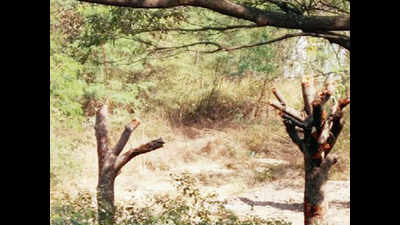- News
- City News
- lucknow News
- 24 districts lost green cover
Trending
This story is from February 14, 2018
24 districts lost green cover
The green cover in the state has registered an increase and is now 9.1% of its geographical area compared to 8.9% earlier, but is still much short of national average of 33%.

Rpresentative image
LUCKNOW: The green cover in the state has registered an increase and is now 9.1% of its geographical area compared to 8.9% earlier, but is still much short of national average of 33%.
The 'State of the Forest Report 2017' released by the Forest Survey of India shows an increase of 616 sq km in the green cover which includes forest and tree cover and attributes the change to 'plantation and conservation'.But, the districts with huge tracts of forest and tiger reserves have lost considerable greens.
While forest cover in the state (assessed through satellite imagery) has increased by 218 sq km compared to 2015 report, tree cover has gone up by 398 sq km in the 2017 assessment. Forest cover is measured for recorded forest area of the state, and tree cover comprises isolated trees outside forest area. Area-wise, tree cover is plantation done on a hectare of land or even less. Forest cover is plantation on a chunk of land bigger than a hectare.
Maximum increase has been in Jhansi, of at least 88 sq km, followed by Mahoba where forest cover increased by 77 sq km.
Bijnor having Amangarh tiger reserve lost 15 sq km; Kheri that has Dudhwa reserve lost 24 sq km and Pilibhit which also has a tiger reserve lost 11 sq km.
Sources said though reasons are not known yet, at some places it could be because of clear felling (clearing old plantation) while in the terai belt it could be because of flood and Sharda river changing its course.
"It could also be an interpretational change due to boundaries of forest not being clear and satellite imagery showing the data for some other site," said sources.
As many as 24 districts show negative growth in forest cover including Shravasti, Gonda, Maharajganj, Mainpuri, Sitapur, Jaunpur, Ballia, Basti, Etah, Deoria and Barabanki.
The biennial report is based on satellite data which is at least a year old. Given that, the 2017 report might be based on the data for 2015 and 2016 and reflect result of the massive plantation drives.
The 'State of the Forest Report 2017' released by the Forest Survey of India shows an increase of 616 sq km in the green cover which includes forest and tree cover and attributes the change to 'plantation and conservation'.But, the districts with huge tracts of forest and tiger reserves have lost considerable greens.
While forest cover in the state (assessed through satellite imagery) has increased by 218 sq km compared to 2015 report, tree cover has gone up by 398 sq km in the 2017 assessment. Forest cover is measured for recorded forest area of the state, and tree cover comprises isolated trees outside forest area. Area-wise, tree cover is plantation done on a hectare of land or even less. Forest cover is plantation on a chunk of land bigger than a hectare.
Maximum increase has been in Jhansi, of at least 88 sq km, followed by Mahoba where forest cover increased by 77 sq km.
In contrast, Mirzapur and Sonbhadra that has Kaimoor wildlife sanctuary lost 33 sq km and 17 sq km forest, respectively.
Bijnor having Amangarh tiger reserve lost 15 sq km; Kheri that has Dudhwa reserve lost 24 sq km and Pilibhit which also has a tiger reserve lost 11 sq km.
Sources said though reasons are not known yet, at some places it could be because of clear felling (clearing old plantation) while in the terai belt it could be because of flood and Sharda river changing its course.
"It could also be an interpretational change due to boundaries of forest not being clear and satellite imagery showing the data for some other site," said sources.
As many as 24 districts show negative growth in forest cover including Shravasti, Gonda, Maharajganj, Mainpuri, Sitapur, Jaunpur, Ballia, Basti, Etah, Deoria and Barabanki.
The biennial report is based on satellite data which is at least a year old. Given that, the 2017 report might be based on the data for 2015 and 2016 and reflect result of the massive plantation drives.
End of Article
FOLLOW US ON SOCIAL MEDIA










